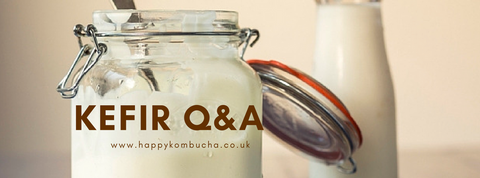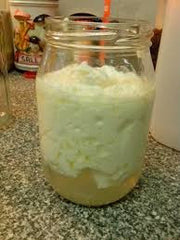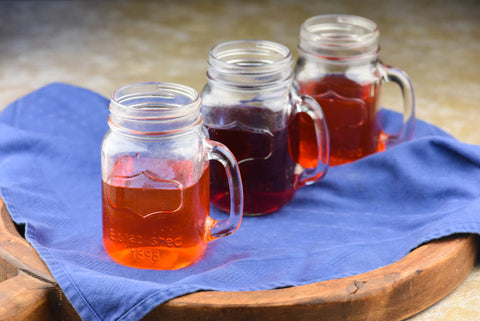Common Kefir Questions

Welcome to our kefir help section. We want you to enjoy your kefir and your brewing experience so we have compiled a list of the most commonly asked kefir questions.
I have left my new grains for 24 hours in milk (or sugar water if water kefir) but nothing has happened are they dead?
No your grains are not dead they are simply settling. As live kefir grains are a living organism they are sensitive to their environment and take a little while to adjust to change. The posting process can be a huge upheaval for the grains as they are taken out of their familiar environment and have a few days of constantly changing conditions. Once they have arrived in their new home it just takes them a little while to catch up and adjust. This is normal and something that ALL live grains will experience. Reducing the amount of milk that you brew with (to around 250ml) and changing their milk regularly (they will be hungry) can help speed up the settling process. Grains often take longer to settle in the winter months than in the summer. You may find that the grains need to settle again if there are any major changes in temperature. When grains are well established (ie you have had them for a while) symptoms of settling are simply that suddenly the kefir they are making is just not quite right, or is thin and watery. This is common in spring and Autumn when the weather can change dramatically quickly, the grains are very temperature sensitive but they can also be affected by atmospheric pressure etc. Simply continue to use the grains as normal if this happens and they will naturally adjust themselves in a couple of brews.
How can i tell if my water kefir is ready?
- Color: The liquid will change color over the 48-hour culturing process. For example, if using white sugar, the plain sugar water will be yellow but finished water kefir will be a more opal color and less translucent. If using a whole sugar containing molasses (e.g., rapadura, Sucanat, etc.), the liquid will change to a different shade of brown (typically a lighter shade of brown).
- Taste: After the 48-hour culturing process, the finished kefir should be less sweet than the sugar water you started with. Please note: finished kefir will still be fairly sweet as it does still contain fructose which is naturally very sweet. But it should be at least a bit less sweet than the original sugar water.
- Smell: The finnished kefir may have a vinegar like smell to it, possibly with a little yeast.

It may take a couple of batches before kefir grains function reliably. It is also common for the taste of the kefir and the activity level of the kefir grains to change over the first 6 to 8 weeks after the kefir grains are recieved. This is a normal part of the process of working with a live culture.
My grains have just arrived however the little sachet has leaked are the grains ruined?
No, we try as hard as possible to stop this from happening however as there is no "off" switch with live grains they continue to ferment in the post. This can at times lead to a bit of leaking from the little sachet and at times it can cause the sachet to burst. There is nothing we can do to prevent this. The little sachet is heat sealed inside the larger sachet to protect the contents so it does not matter if this occurs. The grains will be fine and will brew as normal.
Should i rinse my grains between brews?
There is no real right or wrong answer to this question however it is not something that we would recommend as it may damage the grains. The grains naturally protect themselves in a sticky, slimy goo. This is normal and the grains do this to protect themselves. There is no need to rinse this off. If you do feel the need to rinse your grains then ALWAYS use unchlorinated water (boil the water in the kettle and then allow the water to cool before using)
How do i know when my milk kefir is ready?

Basically when it looks like this, you should be able to see curds and whey (the curds are the thick white bits and the whey is the clear liquid) it will start as little rivers of whey among the curds and will then go to full separation. The kefir is ready as soon as you start to see this and will become more sour the longer you leave it from there. You should also notice that the kefir smells a little sour/vinegary and possibly cheesy/yeasty. The milk will have thickened and it will no longer look like milk.
If you leave the kefir once it is ready or if the weather is warm it can fully separate (see image below) this is not problematic (although it may be a sign that the temperature is too high or you left the brew too long). The kefir will taste rather sour if the brew has fully separated but just give it a good stir and mix it back up again and sieve.

You might also find that your kefir separates like this in the bottle, again this is not problematic just give it a good shake before you drink it. In the warm weather kefir can separate like this very quickly. If this happens you need to consider moving the kefir somewhere a touch cooler and use a little more milk. To sieve the kefir simply give it a good stir and pour through the sieve. Due to the thickness of the curds you may find that you have to keep pouring the liquid that has gone through the sieve back through to keep softening the curds but eventually the curds will break down and you will be left with just the grains in the seive. The kefir is safe to drink but may taste VERY sour.

Try and avoid letting the kefir getting this separated if you can as it can mean that the grains have no food left. If you are getting kefir like this daily then you need to reduce the brewing time/temperature or increase the amount of milk (or possibly a little bit of all).
Should i wash my jar between brews?
Again there is no right or wrong answer here. There are several schools of thought on this matter and i can't really say that any are right or wrong.
- Some people believe that the jar should never be washed as the kefir is a self protecting brew and therefore there is no need.
- Others believe that the jar should be washed with hot water between brews (no detergent) allowed to cool (this is very important as the hot glass may damage the grains).
- Another school of thought is that the jar should be given a quick rinse with warm water (no detergent) after each brew and given a thorough clean every week or so. Another variation on this to simply keep re-using the jar (no rinsing between brews) but to then give it a good clean every week or so (this is the method i prefer)
- Lastly there are those that like to clean there jar out after every brew with detergent and hot water.
if you do decide to use detergent on the jar (or cider vinegar etc) just make sure that you rinse the jar well. It is impossible to rinse too much however if you do not rinse enough the detergent can damage the grains.
Can i use something other than whole cows milk?
Yes, if you would like to use goats or sheep's milk this can be done once the grains have settled. The brewing method is the same however you might find that the grains require a few days to settle every time you change the type of milk you use.
DO NOT USE UHT MILK as it will eventually kill the milk as there is not enough nutrients in it for them.
We do not recommend using skimmed milk to make kefir, although it is technically possible, the kefir that is produced is very thin and watery and it can harm the grains long term. Semi skimmed milk is OK but will not produce the best kefir.
Coconut milk kefir is a perfect if you are looking for a change in your kefir or if you are looking to make a dairy free kefir. Please note Coconut milk kefir is never a vegan alternative as the milk grains need to be kept in dairy milk at least one in every 3 brews to keep the grains happy and healthy.
Ingredients
- Milk kefir grains
- Coconut milk: Fresh homemade, canned or boxed. We recommend avoiding brands with additives and sweeteners as they can be hard on the kefir grains (guar gum, which is a typical additive, does not seem to be problematic).
- Instructions
- To make coconut kefir, just place the milk kefir grains in coconut milk, give the coconut milk a quick stir with a non-metal spoon, cover loosely (a towel works great), and allow the coconut kefir to culture on the counter for 12 to 24 hours.
- After 12 hours, check the coconut kefir every few hours (as possible) so you can remove the kefir grains once the coconut kefir reaches the desired consistency. If your home is on the cool side, it can take longer for the milk kefir to culture.
Sometimes kefir grains will require an adjustment period when changing milks so the first batch of coconut milk kefir may not culture as desired. Use the non-kefired coconut milk for cooking and place the kefir grains in new coconut milk. An adjustment period isn't uncommon whenever kefir grains are switched from one type of milk to another (cow to goat, pasteurized to raw, dairy to coconut, etc.). We recommend only using grains in this way once you have had them for a few weeks. It is not helpful to the initial settling in period if the grains are switched from cows milk.
Milk kefir grains can be cultured in coconut milk regularly but should be allowed to culture in cow or goat milk for 24 hours once every few batches to revitalize.
Note that dehydrated milk kefir grains should be rehydrated in dairy milk and allowed to become fully active before being used to culture coconut milk.
Dairy-free Option: While using milk kefir grains is the most effective way to make coconut milk kefir, there is a truly dairy-free option. Put 1/4 cup water kefir (finished kefir, not the water kefir grains) in 2 to 4 cups of coconut milk. Cover loosely and allow to culture for 24 hours.
How do i store my kefir once it is made?
Kefir (both water and milk) can be stored in the fridge or at room temperature however it tastes better when chilled.
kefir can be stored at room temperature for around 3-5 days or in the fridge for 7-10 days.If you are storing water kefir at room temperature then please read our fermented drinks storage guide and BURP REGULARLY.
How do i look after the grains long term?
The grains will essentially look after themselves, make sure they are well fed and you keep the ratio's correct and at the correct temperature and they will thank you with yummy kefir forever.
Read our good kefir housekeeping guide to see our tips on how to keep the ratio's correct and what to do if you think your kefir is unbalanced.
My kefir grains have suddenly started producing kefir that is very sour, what has gone wrong?
The likely cause of this is that your grains have grown and you now have too many grains. It is very important to regularly remove grains otherwise the kefir grains will use up all the nutrients in the kefir too quickly and become undernourished. They will also make kefir that is very sour. We always recommend storing some grains as a back up (just in case) for long term storage you will need to dehydrate or freeze the grains. The instructions for this can be found here
It is possible that the grains need to be starved, for instructions on how to do this please read our good kefir housekeeping guide.
Once i have dehydrated/frozen a spare set of grains what do i do with the rest?
There are many other uses for milk kefir grains, the most popular are listed below. Other than that you may have to discard your spare grains once you have too many. If you cannot bear to throw them in the bin you can send us your spare grains and we will take care of them for you. If you would like to do this contact Michelle (info@webrewkombucha.co.uk) and she will arrange that for you.
- Grains can be used to ferment vegetable juices (carrot, betroot etc). The ferment is too harsh for the grains so they do not survive the ferment.
- Grains can be used to ferment vegetables
- Grains can be used to make cottage cheese
- Grains can be used to make a sourdough starter
- Grains can be composted, however avoid adding too many at once as they will change the PH of the soil.
Details for all of the above are on the blog
Want to know how to freeze or dehydrate grains? Check out or blog on how to do this here.
I have received my grains a couple of days ago but did not start brewing straight away and did not refrigerate the grains will they be ok?
The grains are hardy little things can can survive in their packaging for up to 6 days at room temperature with no problems, they can actually survive much longer than this is the winter when it is colder and under the right circumstances. The longest i have know grains to survive is around 3 weeks however there are many different factors that are involved in their survival so we can make no guarantees after 6 days.
The only way you will know if your grains have survived is by using them. Follow the instructions however ensure that the grains have fresh milk every 24 hours. If after 7 days of changing the milk every 24 hours the milk still looks like milk and the grains are getting smaller then they are unlikely to recover.
How much kefir should i drink?
It is recommended that you allow your body to adjust to probiotics so start slowly and listen to your body. We do not send out loads of grains initially as otherwise you would end up throwing away more kefir than you drink. Your kefir supply will gradually increase in line with your body adjusting to the probiotics.



